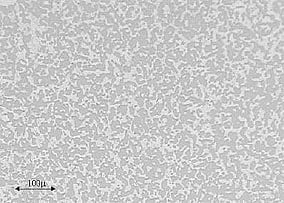Plating and surface treatment
As is evident in the microstructure shown below, controlled expansion alloys (CE alloys) comprise areas of almost pure silicon (Si) interspersed with almost pure aluminium (Al).
In most cases, any plating or coating technique (e.g. electroless plating, chromating, anodizing etc) and any coating material that is normally applied to Si or Al alloys can be used on the CE alloys.
 Osprey® CE11 alloy as polished surface showing ~50% Si (darker phase) and ~50% Al.
Osprey® CE11 alloy as polished surface showing ~50% Si (darker phase) and ~50% Al.
Surface preparation
Prior to coating or plating, care must be taken to ensure that the Si phase is not damaged (i.e. with micro-cracks) during the final machining operation particularly with the high Si alloys (e.g. Osprey® CE7F and CE9F). If the final cuts are made using blunt tools or at the incorrect speed or feed the Si phase can be fractured to a depth of up to 50µm. These fine cracks can soak up chemicals used during plating which are subsequently released and vaporize, resulting in staining and blistering during bake-out tests.
In addition it is important to clean the surface thoroughly of cutting-fluid residues and dust after machining. It is recommended to use ultrasonic (U/S) cleaning techniques before plating. Excessive U/S cleaning can lead to cavitation (as with standard Al alloys), so short U/S treatment times are essential.
Nickel and gold plating
Typically, for the majority of packaging applications, the CE alloys are readily plated with nickel (>7μ of electroless nickel is recommended) followed by a layer of gold (or silver), using standard Al plating procedures.
Provided procedures are carried out correctly (particularly the surface preparation described above), it is possible to obtain well-bonded coatings which will not peel or blister.
Anodizing
Anodizing of the Al phase can be carried out using any standard treatment used for Al. In this case, the effect on the Al surface is identical to what would be expected in any other AlSi alloy. The Si surface will be affected differently depending on the exact method used. The anodized surface will consist of the Al-rich area coated with a wear and corrosion-resistant oxide layer and the Si with a pre-existing thin native oxide layer. The corrosion resistance of the anodized CE alloys is superior to that of the equivalently treated 6000 series alloy.